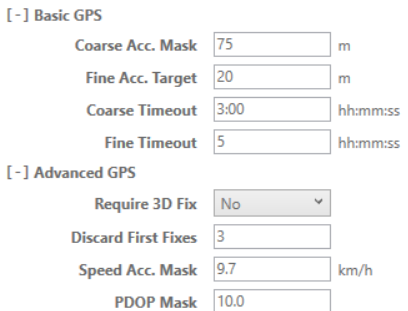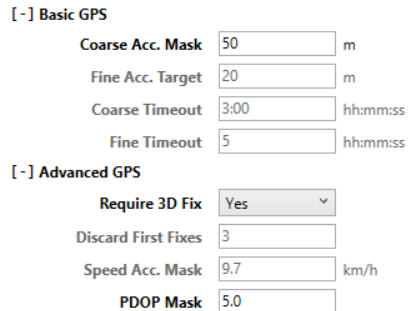Oyster LoRaWAN® - Adjusting GPS Fix Settings
The Oyster provides a number of settings to control the minimum requirements for an acceptable GPS fix.
Each of the settings mentioned in this article are more comprehensively described here.
Devices are shipped with relatively loose requirements for a fix - shown below. This generally speeds up fixes and allows fixes in adverse conditions. Simply put, the device will minimise the time spent with the GPS on. This means that even in good signal conditions, a poor fix may be accepted.
- Coarse Acc. Mask: Position Accuracy (in meters) better (lower) than 75m are accepted.
- Require 3D Fix: No. A 2D Fix is acceptable.
- Discard First Fixes: discard the first 3 fixes once the minimum accuracy is met.
- Speed Acc. Mask: Speed Accuracy (in km/h) better (lower) than 9.7km/h are accepted.
- PDOP Mask: Position Dilution of Precision values better (lower) than 10.0 are accepted.


- Coarse Acc. Mask: Position Accuracy (in meters) better (lower) than 50m are accepted.
- Require 3D Fix: True. A 2D Fix is NOT acceptable.
- Discard First Fixes: discard the first 3 fixes once the minimum accuracy is met.
- Speed Acc. Mask: Speed Accuracy (in km/h) better (lower) than 9.7km/h are accepted.
- PDOP Mask: Position Dilution of Precision values better (lower) than 5.0 are accepted.


- Coarse Timeout: requiring a tighter fix may take longer. Take care not to prevent fixes by setting this timeout too low.
- Fine Timeout and Fine Acc. Target: this feature provides a useful compromise between a loose minimum requirement and an optimistic target. Once the minimum requirements are met, the GPS will stay on for a maximum of Fine Acc. Timeout seconds trying to improve the fix to an accuracy of Fine Acc. Target meters. For example, the minimum position accuracy requirement may be 75m. These settings could allow the GPS to stay on for an additional 5 seconds with the aim of achieving a 20m accuracy. The defaults for these settings are 5 seconds and 20 m.
- Satellite Timeouts: these settings allow fix attempts to be cut short if satellite signal strength is too low to give a fix. If the
n'th satellite is not being tracked with sufficient signal strength before X seconds, end the attempt.
